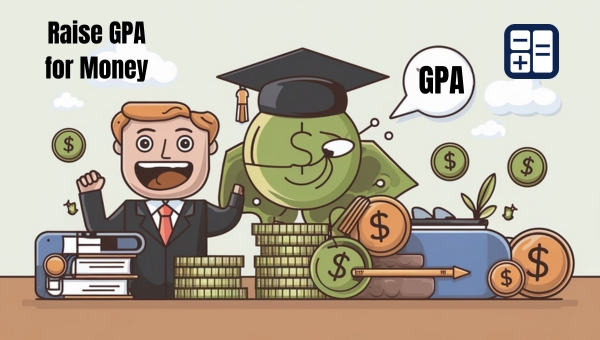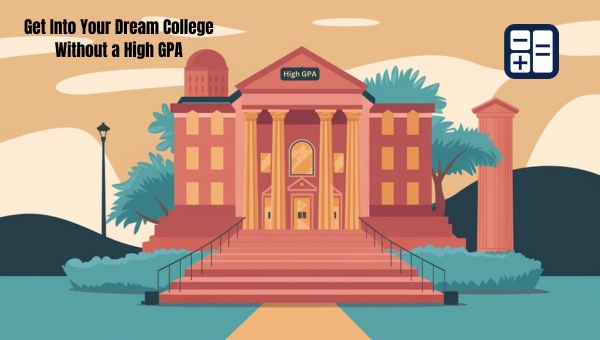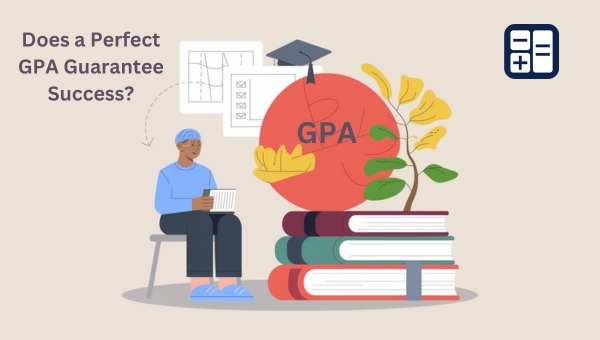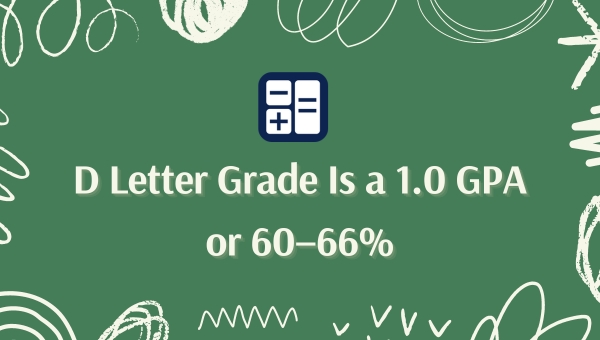2.5 GPA Is a C+ Letter Grade or 77–79%
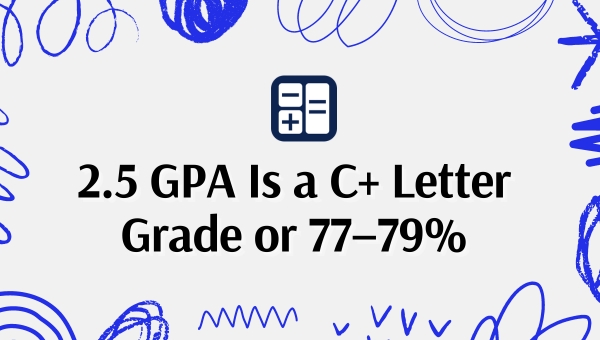
When you see a 2.5 GPA, you’re looking at a C+ letter grade, which translates to a 77-79% performance level. This score suggests you have a solid understanding of the material but there’s definitely room for improvement.
For high school students, this GPA can be a wake-up call to seek extra help in tough subjects and set goals to boost academic performance. Curious about how to quickly raise your GPA and what strategies can help you achieve that? Let’s explore proven tips and actionable steps to help you succeed academically.
What is a 2.5 GPA?
A 2.5 GPA represents a C+ average in most grading systems. This means you’ve earned grades that fall within the 77-79% range. It suggests a decent grasp of the material, but there’s room for improvement. You might’ve some areas where you excel, balanced out by subjects that challenge you more.
Understanding what a 2.5 GPA entails helps you identify where you stand academically. It’s important because your GPA is a key indicator of your overall performance.
If you find certain subjects difficult, it’s a sign that you might need extra help or study more effectively. Conversely, if you’re confident in some courses, focusing on improving weaker areas can boost your overall GPA.
A 2.5 GPA is also a benchmark. It shows that while you’re doing okay, there’s potential for more. Consider it a stepping stone rather than a final destination. Use it as motivation to set academic goals and develop better study habits.
What does a 2.5 GPA mean for high school students?
With a 2.5 GPA, you might find that some colleges are more within reach than others. Safety schools could be a solid option, while target schools may require a bit more effort. Dream schools, on the other hand, might pose a significant challenge but aren’t entirely out of the question.
Safety Schools
While a 2.5 GPA mightn’t open doors to the most competitive colleges, it still holds promise for high school students seeking solid educational opportunities.
You’ll find that many institutions, known as “safety schools,” welcome students with diverse academic backgrounds and provide excellent pathways for further growth.
Here are a few points to consider when exploring safety schools:
- Community Colleges: They offer a flexible, affordable start to your higher education journey, with opportunities to transfer to four-year universities later.
- State Universities: Many state schools have inclusive admissions policies and can provide a comprehensive education without the high-pressure environment of elite institutions.
- Technical and Vocational Schools: These schools focus on practical skills and job readiness, often leading to well-paying careers in a shorter time frame.
- Smaller Private Colleges: Some smaller institutions may have more lenient admission criteria and provide a supportive, personalized educational experience.
- Online Colleges: Offering flexibility and a wide array of programs, online schools can cater to various learning styles and schedules.
Don’t underestimate the value of these options.
They can provide a strong foundation, allowing you to build your GPA, develop skills, and eventually transfer or advance in your chosen career path.
Target Schools
For high school students with a 2.5 GPA, target schools represent a middle ground between highly competitive institutions and safe schools.
You’ll find that target schools are more attainable yet still offer quality education and opportunities. Here’s what a 2.5 GPA means for your target school options:
- Moderate Admission Standards: These schools typically have moderate admission criteria, meaning they look beyond just your GPA. Your extracurricular activities, personal essays, and letters of recommendation will play a significant role.
- Supportive Environments: Many target schools provide resources like tutoring, academic advising, and career services to help you succeed once you’re admitted.
- Flexible Programs: A lot of target schools offer a variety of programs and majors, giving you the flexibility to explore different fields of study.
- Balanced Student Life: These institutions often maintain a good balance between academics and social life, ensuring you have a well-rounded college experience.
- Financial Aid Opportunities: Target schools can also offer substantial financial aid packages, making higher education more affordable for you.
Dream Schools
Dream schools can seem like a far-off aspiration for high school students with a 2.5 GPA, but don’t let that discourage you. A 2.5 GPA, which translates to a C+ letter grade or 77-79%, isn’t the end of your academic journey.
Instead, think of it as a starting point for improvement and growth. Here are some actionable steps you can take to boost your chances of getting into your dream school:
- Focus on your strengths: If you’re strong in certain subjects, aim to excel further in those areas. Colleges often look for specialized talents.
- Extracurricular activities: Join clubs, sports, or volunteer programs. A diverse resume can make you stand out.
- Strong letters of recommendation: Build relationships with teachers and mentors who can vouch for your character and potential.
- Improve standardized test scores: High SAT or ACT scores can balance out a lower GPA.
- Craft a compelling personal essay: Share your unique story, challenges, and how you’ve overcome them. Authenticity can resonate with admissions officers.
Proven Tips to Get a 2.5 GPA
To boost your GPA to a 2.5, focus on effective study strategies and time management techniques.
Don’t hesitate to seek academic help, participate actively in class, and maintain healthy lifestyle habits.
These proven tips can make a significant difference in your academic performance.
Effective Study Strategies
Achieving a 2.5 GPA might seem daunting, but with the right study strategies, it’s entirely within your reach. Start by setting clear, achievable goals for each study session. Instead of vague objectives like “study history,” aim for specifics such as “review chapters 3 and 4 of the history textbook.”
Next, embrace active learning. Don’t just read your notes—engage with the material. Use flashcards, summarize information in your own words, or teach the content to someone else. These methods help reinforce your understanding and retention.
Additionally, take effective notes during classes. Focus on key concepts, dates, and definitions. When reviewing, highlight or underline important points to make them stand out.
Break your study sessions into manageable chunks. The Pomodoro Technique, which involves studying for 25 minutes and then taking a 5-minute break, is a great method to maintain focus and prevent burnout.
Lastly, don’t hesitate to seek help. Join study groups, attend tutoring sessions, or ask your teachers for clarification on topics you find challenging. Collaborating with others can provide new insights and make studying less isolating.
Time Management Techniques
Getting a handle on time management can make a world of difference when aiming for a 2.5 GPA. First, start by creating a weekly schedule. Use tools like planners or digital calendars to map out your classes, study sessions, and relaxation time. Stick to this schedule to ensure you’re consistently making progress.
Next, prioritize your tasks. Identify which assignments or study sessions are most crucial and tackle those first. This helps in preventing last-minute cramming, which often leads to lower grades.
Break larger tasks into smaller, manageable chunks. Doing so makes even the most daunting assignments feel achievable and keeps you from feeling overwhelmed.
Another effective technique is the Pomodoro method. Set a timer for 25 minutes and focus solely on one task. After the timer goes off, take a 5-minute break. Repeat this cycle four times, and then take a longer break. This keeps your mind fresh and boosts productivity.
Lastly, minimize distractions. Find a quiet study space where you won’t be interrupted. Turn off notifications on your phone and limit social media use during study times.
Seeking Academic Help
Wondering how to effectively seek academic help to boost your GPA? Start by recognizing when you need assistance. If you’re struggling with a particular subject, don’t wait until it’s too late. Reach out to your teachers during their office hours. They can provide personalized guidance and clarify any confusing material.
Consider forming or joining a study group. Collaborating with classmates allows you to gain different perspectives and fill in knowledge gaps. Plus, explaining concepts to others reinforces your own understanding.
Tutoring services are another excellent resource. Many schools offer free tutoring; take advantage of it. If your school doesn’t, there are plenty of online tutoring options available. A tutor can help you focus on problem areas and develop better study habits.
Don’t overlook the power of academic advisors. They can assist you in planning your coursework and ensuring you’re meeting all necessary requirements. They might also help you identify additional resources you hadn’t considered.
Lastly, use online resources like educational videos, forums, and practice problems. Websites like Khan Academy and Coursera offer free courses on various subjects.
Seeking help is a sign of strength, not weakness. Stay proactive, and you’ll see your GPA improve.
Classroom Participation Tips
In addition to seeking academic help, active classroom participation plays a significant role in improving your GPA. Engaging in class discussions shows your professors that you’re interested and invested in the material. Start by sitting at the front to minimize distractions and maximize focus.
Always come prepared. Review your notes before class and read assigned materials. This preparation will give you the confidence to ask insightful questions and contribute meaningfully to discussions. Don’t be afraid to ask for clarification if you’re confused; chances are, others have the same question.
Participate regularly but don’t dominate the conversation. Aim to make thoughtful contributions that add value. Listen actively to your classmates and build on their points. This can help create a collaborative learning environment, which professors appreciate.
Take advantage of any opportunities for group work or presentations. These activities often carry participation grades and can significantly boost your overall score.
Lastly, make sure you’re respectful and attentive. Showing that you care about the class and your peers can positively influence your participation grade.
Healthy Lifestyle Habits
Achieving a balanced GPA involves more than just hitting the books; it requires adopting healthy lifestyle habits that support your academic goals.
Start by prioritizing your sleep. Aim for 7-9 hours each night to ensure you’re well-rested and ready to tackle the day’s challenges. A well-rested mind can improve concentration and memory, crucial for maintaining a 2.5 GPA.
Next, focus on your diet. Eating balanced meals rich in fruits, vegetables, proteins, and whole grains fuels your brain and body, giving you the energy to excel in your studies.
Don’t skip breakfast; it jump-starts your metabolism and keeps your energy levels stable throughout the day.
Exercise regularly. Physical activity boosts endorphins, which can reduce stress and enhance your mood. Even a 30-minute walk can clear your mind and increase productivity.
Time management is another key habit. Use a planner or digital calendar to keep track of assignments, exams, and study sessions. Break tasks into smaller, manageable chunks to avoid feeling overwhelmed.
Lastly, don’t underestimate the power of taking breaks. Short, frequent breaks during study sessions can prevent burnout and keep your mind sharp.
How to Raise Your GPA Fast?
Boosting your GPA quickly requires strategic planning and effective study habits. First, identify the subjects where you’re struggling the most. Focus extra time and effort on these classes.
Seek help from your teachers, attend tutoring sessions or form study groups with classmates. Don’t hesitate to ask questions; clarifying doubts can make a significant difference.
Next, organize your time efficiently. Create a study schedule that allocates specific time slots for each subject, ensuring you cover all material. Prioritize assignments and projects by their due dates and impact on your overall grade. Consistent, daily study sessions are more effective than cramming.
Active learning techniques can also help. Use flashcards, practice quizzes, and summarization to reinforce key concepts. Teaching the material to someone else can be a powerful way to solidify your understanding.
Additionally, take advantage of extra credit opportunities when available. They can provide a valuable boost to your grades.
Conclusion
Raising your GPA from 2.5 can seem daunting, but it’s absolutely doable with dedication and the right strategies. By understanding what a 2.5 GPA means and identifying areas for improvement, you can set realistic goals. Seek additional help, stay organized, and stay motivated.
With consistent effort, you’ll see your grades improve, opening up more opportunities for your future. Remember, every small step counts towards achieving academic success. Go for it; you can do this!
